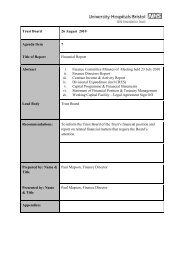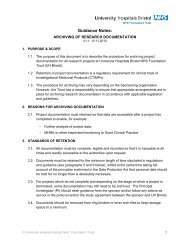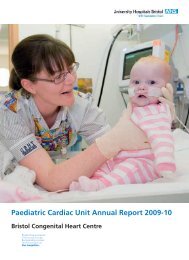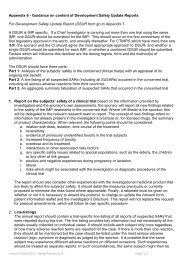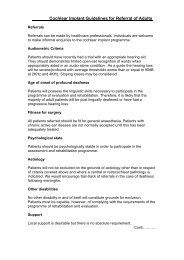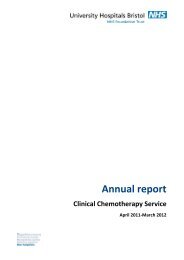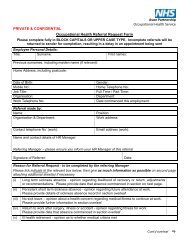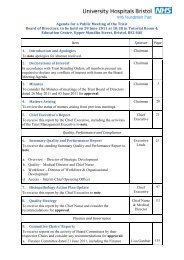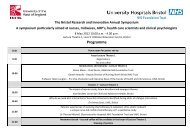Supervisors of Midwives - United Bristol Healthcare NHS Trust
Supervisors of Midwives - United Bristol Healthcare NHS Trust
Supervisors of Midwives - United Bristol Healthcare NHS Trust
You also want an ePaper? Increase the reach of your titles
YUMPU automatically turns print PDFs into web optimized ePapers that Google loves.
<strong>Supervisors</strong> <strong>of</strong> <strong>Midwives</strong>St. Michaels Hospital, <strong>Bristol</strong>Annual Report 2008-2009IntroductionUniversity Hospitals <strong>Bristol</strong> <strong>NHS</strong> Foundation <strong>Trust</strong> (UH<strong>Bristol</strong>) maternity servicedelivers acute and community maternity care to a diverse population from inner cityclients with associated socio-economic deprivation and minority ethnic groups(including a large Somalian refugee population and an increasing influx <strong>of</strong> immigrantsfrom Eastern Europe) to remote rural areas. Services range from midwife–led careto high-risk care, with regional referrals to the fetal and maternal medicine units.Some areas <strong>of</strong> the city <strong>of</strong> <strong>Bristol</strong> served by the Service have traditionally had a highnumber <strong>of</strong> home confinements.Commissioners<strong>NHS</strong> <strong>Bristol</strong> and North Somerset are main commissioners <strong>of</strong> the service but patientsfrom Bath And North East Somerset (BANES) and South Gloucestershire also usethe service.Details <strong>of</strong> current <strong>Supervisors</strong> <strong>of</strong> <strong>Midwives</strong>The following are currently designated as <strong>Supervisors</strong> <strong>of</strong> <strong>Midwives</strong> (SOMs) by theLocal Supervising Authority (LSA) and are working at St Michaels Hospital:Belinda CoxDi DorringtonLisa DamsellMary DaviesJenny FordEsther HatfieldJackie Moxham (had career break from May 08 – March 09)Susan MurphyJulie NorthropSiobhan O‟Callaghan (currently works as a bank midwife)Janet PollardAnn TizzardSarah Windfeld (Link Supervisor)Amanda Harris was on secondment to UH<strong>Bristol</strong> from North <strong>Bristol</strong> <strong>Trust</strong> betweenMay 08 and March 09, and looked after Jackie Moxham‟s supervisees while JM wason career break.Sarah Green (SG) also supervises midwives from St Michael‟s Hospital. She has abank midwifery contract at St Michael‟s and is Associate Head <strong>of</strong> Nursing &Midwifery at the University <strong>of</strong> the West <strong>of</strong> England. She was on Maternity leavebetween July 08 and April 09, and now plans to take a year‟s sabbatical from SOM. Itis anticipated that she will resume Supervision in June 2010. SG‟s caseload will beheld by Janet Pollard in the meantime.1 <strong>of</strong> 9SOM Annual Report June 2009UH<strong>Bristol</strong>
Sara-Jane Sheldon will be joining the <strong>Trust</strong> at the end <strong>of</strong> June and it is anticipatedthat she will hold a caseload <strong>of</strong> supervisees soon afterwards.There have been no Supervisor <strong>of</strong> <strong>Midwives</strong> resignations or removals this year.Alison Kirby is currently undertaking the Preparation for <strong>Supervisors</strong> <strong>of</strong> Midwifescourse at the University <strong>of</strong> the West <strong>of</strong> England.Details <strong>of</strong> how midwives are provided with continuous access to a Supervisor<strong>of</strong> <strong>Midwives</strong><strong>Midwives</strong> are given an opportunity to vote for the SOM <strong>of</strong> their choice. When newmidwives start they are given brief biographies <strong>of</strong> each SOM to help them make theirchoice in order <strong>of</strong> preference (1 st , 2 nd or 3 rd ). They are then allocated according tothe caseload <strong>of</strong> each SOM. This means that midwives may not have their 1 st choice<strong>of</strong> SOM if that SOM caseload is full. All midwives were given the opportunity to „revote‟for their SOM at the beginning <strong>of</strong> 2006, and it is anticipated that this exercisewill be repeated towards the end <strong>of</strong> 2009.Each midwife is given details regarding how to contact their named SOM.If their named SOM is not available the midwife can, during <strong>of</strong>fice hours, contact anySOM who is on duty or contact the „On Call‟ SOM via switchboard.Out <strong>of</strong> hours there is a SOM „On Call‟ 24/7, contactable via switchboard.There are currently 211 midwives supervised including 1 Independent Midwife, 1Midwife working at University <strong>of</strong> the West <strong>of</strong> England (UWE), 1 Midwife working forthe National Patient Safety Agency (NPSA), 1 midwife working in a privatechiropractic practice, and 1 midwife working as Deputy Regional ScreeningCoordinator for Antenatal and Child Health for the South West Region. Caseloadscurrently range from 0 to 22 midwives, the current ratio being 1:17 (pro-rata).Details <strong>of</strong> how midwifery practise is supervisedSOMs meet monthly and follow a standard agenda which includes among otherthings discussion on clinical incidents, child protection, „On Call‟ issues and newguidelines that have been introduced during the preceding month. These meetingsgenerally last about an hour and a half.We also meet on a more ad hoc basis to deal with any specific projects, and thiscurrently includes the development <strong>of</strong> a Midwifery Strategy for UH<strong>Bristol</strong>.We also have 3 meetings each year with SOMs in neighbouring <strong>Trust</strong>s to discusscross border issues.Following serious clinical incidents or incidents that highlight practice issuesassociated with individual midwives the named SOM is contacted to provide supportto that midwife.2 <strong>of</strong> 9SOM Annual Report June 2009UH<strong>Bristol</strong>
Each midwife is <strong>of</strong>fered an annual SOM review meeting with his or her named SOM.Depending on the individual need for support, midwives are <strong>of</strong>fered additionalmeetings as required. The supervisory review meeting is individualised to meet theneeds <strong>of</strong> each midwife, and the majority <strong>of</strong> SOMS now use the LSA database torecord the annual review. It has been agreed locally that all the SOMs will use thedatabase from now on.<strong>Midwives</strong> who fail to attend for their supervisory meeting are contacted and additionalappointments are <strong>of</strong>fered, along with the opportunity to change their SOM if that isthe reason why the midwife has not attended. Line managers are informed andfurther support <strong>of</strong>fered to encourage the uptake <strong>of</strong> annual reviews.A SOM takes the midwifery lead on all multidisciplinary working parties and aretherefore key in the development <strong>of</strong> new guidelines and patient information.<strong>Supervisors</strong> also attend the clinical governance, risk management and perinatalmortality and morbidity meetings.Evidence that service users have been involved in monitoring supervision <strong>of</strong>midwives and assisting the local supervising authority midwifery <strong>of</strong>ficer withthe annual auditsLocally there have been problems engaging service users with Supervision <strong>of</strong><strong>Midwives</strong>. A user representative had been identified and attended some <strong>of</strong> themonthly meetings. Unfortunately due to personal circumstances she is no longer ableto attend meetings.Evidence <strong>of</strong> engagement with higher education institutions in relation tosupervisory input into midwifery educationSt Michael‟s hospital is a busy teaching hospital and as such <strong>of</strong>fers clinicalplacements for a number <strong>of</strong> midwifery students. These placements occur both ondelivery suite, the wards and community areas. This is an integral component <strong>of</strong>midwifery training as the pre registration programmes operates on a fifty- fifty splitbetween theory and practice. Therefore, St Michael‟s has close links with the preregistration programme <strong>of</strong> which <strong>Supervisors</strong> <strong>of</strong> <strong>Midwives</strong> have key roles. There isan educational supervisor linked with St Michael‟s and their role helps ensure thatthere are effective links and communication between higher education and practice.All students are allocated a supervisor <strong>of</strong> midwives and given information <strong>of</strong> why andhow to access the designated individual. This supervisor <strong>of</strong> midwives becomes theirnamed supervisor for the duration <strong>of</strong> their training.Supervisor <strong>of</strong> midwives are directly involved in programme development for both preand post registration midwifery education. Programme management committeeshave supervisor <strong>of</strong> midwives present that are able to provide relevant feedback andadvice on how to in corporate midwifery supervision into all aspects <strong>of</strong> midwiferyeducation. <strong>Supervisors</strong> <strong>of</strong> <strong>Midwives</strong> are also involved in teaching pre registrationstudents and this has helped raise the understanding and pr<strong>of</strong>ile <strong>of</strong> midwiferysupervision. In addition, <strong>Supervisors</strong> <strong>of</strong> <strong>Midwives</strong> are involved in the preparation andteaching on the Preparation for <strong>Supervisors</strong> course and Return to Midwifery Practice.3 <strong>of</strong> 9SOM Annual Report June 2009UH<strong>Bristol</strong>
These activities have helped form a partnership between higher education andmidwifery supervision, which has resulted in a mutually beneficial relationshipwhereby both organisations are kept informed <strong>of</strong> activities and supervision <strong>of</strong>midwives is able to impact on and develop education.In 2009/10 the Pre Registration Midwifery programme is undertaking the process<strong>of</strong> revalidation. This is part <strong>of</strong> revalidation for all pre registration nursing andmidwifery at UWE. This will further modernise the curriculum and ensure thatmidwives are equipped with the skills, knowledge and attributes for the needs <strong>of</strong>mothers and their families and the changing workforce. <strong>Supervisors</strong> <strong>of</strong> <strong>Midwives</strong>have, and will continue to have, an essential role in helping to formulate and reviewthis work, and as such have been part <strong>of</strong> the Educational Development Unit forMidwifery education at UWE. This work will help further promote and embed therole and work <strong>of</strong> midwifery Supervision.Details <strong>of</strong> any new policies / guidelines related to the supervision <strong>of</strong> midwivesA joint guideline has been developed and ratified by SOMs across <strong>Bristol</strong> to guidemidwives when dealing with suspected or actual Freebirthing.Evidence <strong>of</strong> developing trends affecting Midwifery practice.The general caseload accessing the service is increasing in complexity, with moreethnic diversity, obesity, diabetes and other maternal medical problems, and age.Guidelines are being developed where appropriate to inform the multi-pr<strong>of</strong>essionalteam.There are more women planning to birth their babies at home against advice frommidwifes and obstetricians. Notably within the last year we have had 2 women with atwin pregnancy, one <strong>of</strong> whom was also a Vaginal Birth After Caesarean (VBAC), planto birth at home, as well as other cases with VBAC. One woman with Group BStreptococcus is currently planning a home birth.Complex child protection and domestic abuse issues are increasing, requiring moreinput from midwives and <strong>Supervisors</strong>.The number <strong>of</strong> women requiring Maternal Critical Care (MCC) in the antenatal,intrapartum and early postnatal period is increasing. A MCC study days has beendeveloped to support the midwives knowledge and skills <strong>of</strong> MCC.There are more Maternity Support Workers in post on the community, and there are3 band 5 nurses working in the hospital to support the midwives in delivering care.The number <strong>of</strong> women having successful Vaginal Birth After Caesarean (VBAC) isincreasing through work using the <strong>NHS</strong> Institute Toolkit „Focus on: CaesareanSection‟. VBAC success rates are advertised within the unit to the multi-pr<strong>of</strong>essionalteam and women accessing the service.4 <strong>of</strong> 9SOM Annual Report June 2009UH<strong>Bristol</strong>
Details <strong>of</strong> the number <strong>of</strong> complaints regarding the discharge <strong>of</strong> the supervisoryfunctionThere have been no complaints around the discharge <strong>of</strong> the supervisory function.Organisational ChangesThe community midwifery matron‟s role has been filled by 2 SOMs who have jobsharedsince the previous matron resigned from the role. A new matron (Sara-JaneSheldon) has been recruited and is starting in the <strong>Trust</strong> at the end <strong>of</strong> June.The number <strong>of</strong> transitional care beds has been increased by 4, and the criteria foradmission to the ward has been revised.Work continues to implement changes following the completion <strong>of</strong> the <strong>Bristol</strong> HealthServices Plan, the Maternity and Newborn Services review led by the <strong>Bristol</strong> PrimaryCare <strong>Trust</strong> (PCT). SOMs are involved in all 6 <strong>of</strong> the work streams that have been setup.New Developments within the ServiceA review <strong>of</strong> the Avon handheld maternity notes was jointly led by the <strong>Supervisors</strong> andchanges have been incorporated to include recommendations from ConfidentialEnquiry into Maternal and Child Health (CEMACH), NPSA and the National Institutefor health and Clinical Excellence (NICE) antenatal, intrapartum, postnatal andmental health guidance these notes will be introduced later this year.The Head <strong>of</strong> Midwifery together with the supervisors have been successful inobtaining funding from the PCT to increase the midwifery establishment to assist inincreasing the normal and home birth rate.New specialist midwife roles have been developed to include diabetes, teenagepregnancy and screening.A further two research midwives have been appointed to nationally recognisedprojects.A new midwifery role has been developed to provide support for the maternitysupport workers in the community and to assist in the safe development <strong>of</strong> their role.The Head <strong>of</strong> Midwifery is leading on equality and diversity for the Division and chairsthe PCT workstream on the same subject. Maternity focus groups for the Somalipopulation have also been facilitated and attended by <strong>Supervisors</strong>.Infant FeedingSt. Michael's was accredited as Baby Friendly in May 2007. Internal audits continueto ensure we continue to meet this high standard <strong>of</strong> care and we will be reassessedby Baby Friendly in October 2009. Being accredited as Baby Friendly ensures that5 <strong>of</strong> 9SOM Annual Report June 2009UH<strong>Bristol</strong>
we are compliant with the NICE Postnatal and Maternal and Child NutritionGuidelines.Joint working with <strong>Bristol</strong> PCT continues and has been enhanced by St Michael‟sinfant feeding coordinator‟s secondment to the PCT to manage the Baby Friendlyproject across <strong>Bristol</strong>( May 2008- June 2009). Stage 2 assessment has been passedand stage 3 assessment is planned for October 2009, after which time <strong>Bristol</strong> will beproviding 100% maternity and Health Visiting services that meet Baby FriendlyInitiative standards.Good practice and achievements for the yearThe <strong>Supervisors</strong> have set up a “SOM cafe” to allow staff to meet on an informal basiswith supervisors to discuss midwifery issues. Comments and ideas from thesemeetings have been incorporated in to the draft midwifery strategy currently underdevelopment by the <strong>Supervisors</strong>A Supervisor has taken the lead for essence <strong>of</strong> care within the maternity service,work has been completed on privacy and dignity and communication. The group iscurrently looking at pressure area care.<strong>Supervisors</strong> continue to run regular teaching sessions on documentation formidwives as part <strong>of</strong> their mandatory training.A Supervisor <strong>of</strong> <strong>Midwives</strong> takes a shared lead <strong>of</strong> a multidisciplinary group looking atimproving vaginal birth after caesarean section.<strong>Supervisors</strong> <strong>of</strong> <strong>Midwives</strong> have developed a study day on normal birth.The <strong>Supervisors</strong> have developed a “Hot Topic” information sheet for <strong>Midwives</strong> whichis produced quarterly giving up to date advice on relevant midwifery subjects.Pro- active supervisory support and attendance at home birth against midwifery andmedical advice has increased to provide support for women and midwives.Two <strong>Supervisors</strong> attended the <strong>NHS</strong> Institute for Innovative Improvement workshopon normalising birth.The Obstetric Emergency Skills Day is led by a Supervisor. It is delivered as a multipr<strong>of</strong>essionalday with teaching and attendance from midwives and obstetricians.Ongoing evaluation and development takes place to improve the delivery andlearning experiences <strong>of</strong> the attendees.The maternity service has instigated and integrated the Royal College <strong>of</strong>Obstetricians & Gynaecologists (RCOG) Dashboard into the <strong>Trust</strong>‟s performancereport. This report is reviewed monthly by the Women‟s Clinical GovernanceCommittee and <strong>Trust</strong> Board, and has highlighted a midwife to birth ratio <strong>of</strong> almost1:39. This has enabled the Head <strong>of</strong> Midwifery to successfully bid for extra midwives,although the exact number is still under debate.6 <strong>of</strong> 9SOM Annual Report June 2009UH<strong>Bristol</strong>
Benchmarking workThe Maternity Service has implemented the Maternity Dashboard and continues todevelop it to meet local needs. The Dashboard is reported to the Clinical GovernanceCommittee and the Divisional board.All National Institute for health and Clinical Excellence (NICU); National ConfidentialEnquires (e.g. CEMACH, NCEPOD, CISH) National Patient Safety Alerts arereviewed within a month <strong>of</strong> publication. A compliance / audit report is produced andan action plan made. The action plans are monitored by the Women‟s ServiceClinical Governance Committee.St. Michaels is a part <strong>of</strong> the South West obstetric Network (SWON) that works onjoint guidelines to ensure consistency across the region.Current level <strong>of</strong> CNST achievementLevel 3 achieve in March 2007. The maternity service acted as a pilot site for thenew <strong>NHS</strong> Litigation Authority (<strong>NHS</strong>LA) maternity standards in November 2008.Reassessment using the new standards is due in November 2009, and work is takingplace in preparation for this. An informal visit by the Clinical Negligence Scheme for<strong>Trust</strong>s (CNST) assessors in August will inform the decision on which level to beassessed at.Number <strong>of</strong> SUIs reported to the SHADuring this reporting period the maternity service has experienced high workload with5236 births. The maternity service has instigated and integrated the RCOGDashboard into the <strong>Trust</strong>‟s performance report. This report is reviewed monthly bythe <strong>Trust</strong> Board and has highlighted a midwife to birth ratio <strong>of</strong> almost 1:39. This hasenabled the Head <strong>of</strong> Midwifery to successfully bid for increased midwifery hours.Except for 3 months the caesarean section rate has remained below 25% <strong>of</strong> totalbirths and the instrumental rate is on average 14%. This against a backdrop <strong>of</strong> 1% <strong>of</strong>babies being born in „poor condition‟ e.g. with a 5 minutes Apgar Score <strong>of</strong> less 7.There has been one maternal death. This mother was delivered in Bath andtransfered to the <strong>Bristol</strong> Royal Informary as she has a ruptured liver. The root causeanalysis was undertaken by the base hospital.Reports to legal services:13 cases have been reported to legal services in anticipation <strong>of</strong> a claim:- 5 x Hypoxia Ischaemic Encephalopathy (HIE) grades 2/3 5 x Erbs palsy 1 x Retained swab – This was one <strong>of</strong> 9 incidents, since 2007, involving aretained swabs.1x Maternal death1 x Delay in obtaining accurate blood reports that influenced the woman‟smanagement.7 <strong>of</strong> 9SOM Annual Report June 2009UH<strong>Bristol</strong>
Root Cause Analysis:The service conducted 11 Level 1 and 3 level 2 root cause analyses during theperiod <strong>of</strong> this report. Of these RCA’s one has been reported to the SHA as aSerious Untoward Incident (SUI). This SUI caused no actual harm to the mother.However, the investigation identified <strong>Trust</strong> wide deficiences in the storage and control<strong>of</strong> Heparin, which is now the subject <strong>of</strong> an external review, „The T<strong>of</strong>t Report‟ in 2007,in the Childrens Hospital.High Risk incidents:49 „High Risk‟ incidents. (No „High Risk‟ incidents in month 9 [September 2008]) havebeen reported during the period covering this report. 32 <strong>of</strong> these incidents involved capacity issues on Central Delivery Suite (CDS).On 30 occasions the CDS attempted or did close referring 38 women to otherhospitals. One incident form reported 23 occasions, during the month <strong>of</strong> April2008, when the CDS was busy and inductions <strong>of</strong> labour were delayed.36 „Catastrophic incidents‟ all <strong>of</strong> these were unavoidable stillbirths which areroutinely reviewed at the monthly mortaility meetings. There is poor attendance<strong>of</strong> midwives at these meetings. The „Risk Rating‟ <strong>of</strong> unavoidable catastrophicstillbirth incidents are classified, in this unit as „Low Risk‟.Number <strong>of</strong> supervisory investigations by <strong>Trust</strong>There was 1 midwife who successfully completed 6 weeks supported practice thisyear. There have been no midwives undertaking supervised practice.Specific problems or challenges throughout the past year or envisaged for theforthcoming yearOur main challenge remains staffing levels within midwifery and this will continueeven with successful appointment to the new funded establishment as the unit willstill fall below the national recommended levels.Within the next year we will be considering re configuration <strong>of</strong> the service in order toachieve recommendations from maternity mattersNumbers <strong>of</strong> closures <strong>of</strong> delivery suite remains a concern and is likely to do so for theforth coming year.It has been a disappointment that a bid for capital funding to develop a stand alonebirthing suite was unsuccessful and the challenge will be how to provide this servicewithin the current layout <strong>of</strong> delivery suite.There appears to be an increase in demand for homebirth against midwifery andmedical advice requiring extra support from supervisors acknowledging the stress forall staff involved.8 <strong>of</strong> 9SOM Annual Report June 2009UH<strong>Bristol</strong>
Generally issues around Child Protection and Domestic Abuse continue to increasein number and complexity, and resource pressures within the Social Work servicehave compounded this.Numbers <strong>of</strong> women accessing the service remain high with 5321 births in 2007/08and 5236 in 2008/09. The caseload is also becoming increasingly complex, withmore women having associated medical or obstetric conditions.The unit continues to struggle to cope with this high workload with 30 closures <strong>of</strong>delivery suite in 2008/09 on a case by case base. However due to increasingbookings in neighbouring <strong>Trust</strong>s, closure in this way is becoming increasingly difficult.The workforce remains „bottom-heavy‟ in relation to midwifery experience, withrecruitment being mainly from newly qualified midwives. This is likely to be anongoing problem as there is an increasingly ageing workforce with a number <strong>of</strong>retirements planned over the next few years, particularly affecting the communitymidwifery services. The problems for the community midwifery service iscompounded by a number <strong>of</strong> midwives on long-term sick leave with serious illnesses.Recruitment has been ongoing, and attempts are being made to recruit moreexperienced midwives.<strong>Supervisors</strong> <strong>of</strong> <strong>Midwives</strong>University Hospitals <strong>Bristol</strong> <strong>NHS</strong> Foundation <strong>Trust</strong>June 20099 <strong>of</strong> 9SOM Annual Report June 2009UH<strong>Bristol</strong>



